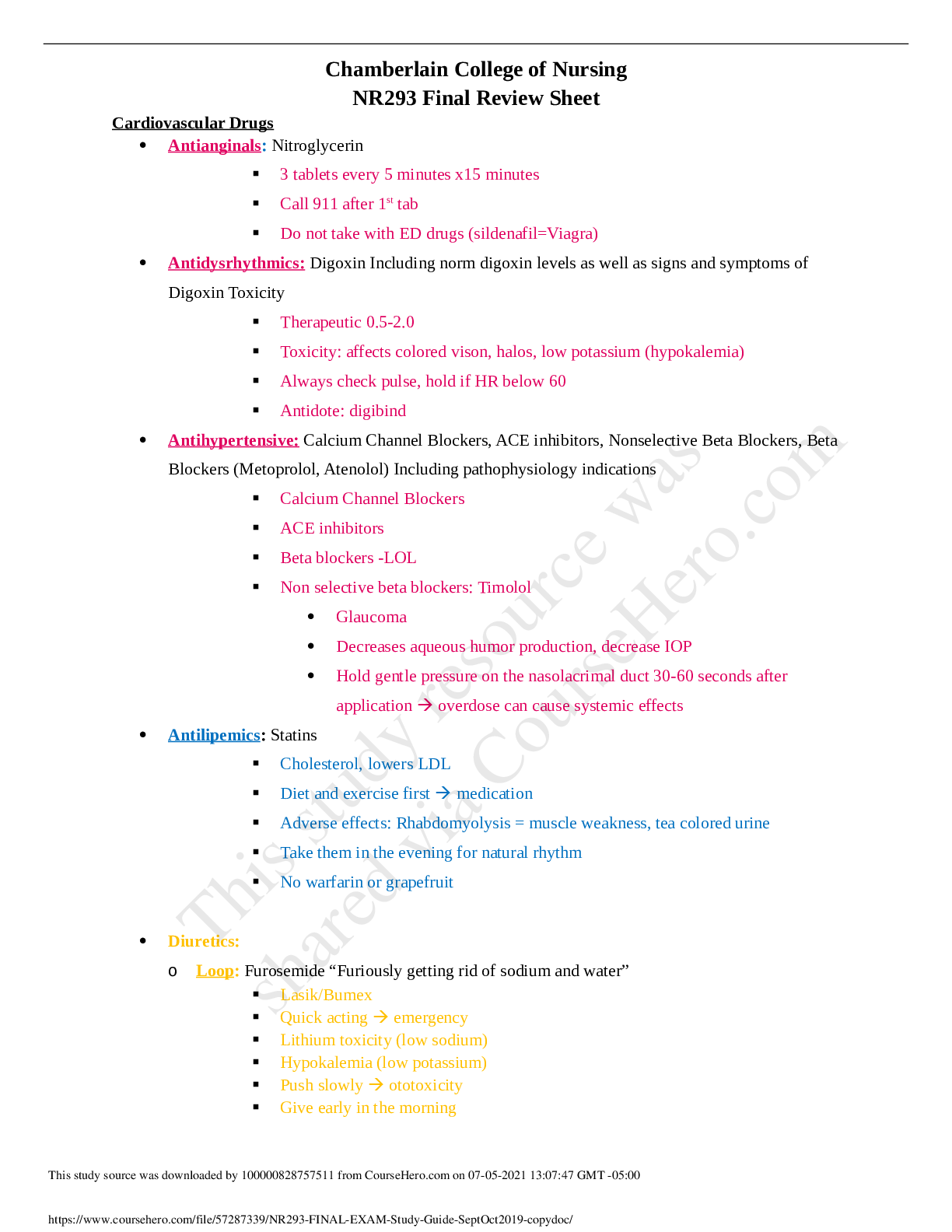*NURSING > Final Exam Review > NR 283-Final Exam Study Guide (All)
NR 283-Final Exam Study Guide
Document Content and Description Below
Final Exam Study Guide Neurological Clinical Manifestations for alterations in arousal o Changes in LOC is the most critical piece on information we have o LOC: are early changes, first thing ... you will see when something goes wrong neurologically o Pattern of breathing: assess the rate, rhythm and pattern; can have changes in any of those. Respiratory rate can be low or labored. Could have Cheyne stroke respirations o Pupillary Changes: biggest thing to look for fixed and dilated pupils. (Pupils are wide and don’t move). This is not good, its sign of brain hypoxia or ischemia. o Oculomotor Responses: just looking for changes and or things your not supposed to have. Resting, spontaneous, reflexive eye movements o Motor Responses: Can help evaluate level of dysfunction and damaged side ( just looking for changes or things that shouldn’t be there) Purposeful, inappropriate, or not present o Consciousness: state of awareness of oneself and the environment Arousal: state of being awake and being able to respond Awareness: state of being aware These are all mediated by the RAS, in brainstem If you get damage to cerebrum then the RAS will maintain you in a vegetative state- will keep you alive if something happens severely to your brain tissue. o Structural: could be due to a tumor, bleeding in the brain o Metabolic: anything that effects the metabolism like hypoxia, electrolyte changes, medications or drugs o Psychogenic: patients with psychiatric diseases like schizophrenia o Outcomes: Long-term disabilities, or patients could die. Brain Death: body can no longer maintain internal homeostasis o Occurs when the brain has been damaged so severely that it can never recover. Death or damage to the brain stem. These patients are considered legally dead Cerebral death : irreversible damage to the cerebrum but the cerebellum and brain stem maintain intact- because the cerebellum and brainstem are intact, all vitals can be maintained, your still alive, just not where you want to be o 4 types: o Remain in coma for life: they will have vital signs, but will not move, talk or open their eyes etc. o Emerge into a persistent vegetative state: the only thing they can do is open their eyes and have normal sleep patterns. Will have vital signs [Show More]
Last updated: 2 years ago
Preview 1 out of 31 pages

Buy this document to get the full access instantly
Instant Download Access after purchase
Buy NowInstant download
We Accept:

Also available in bundle (2)

NR 293 Study guide,exam guide, case studies, questions & answers and Final exam
1. Study guide 2. Questions and Answers 3. Case studies 3. Exams guide 4. Discussions 5.Final exams
By Canzalo 4 years ago
$106.5
13

NR 283 study guide, exam 1,2,case studies, final exam guide
1. Study guides 2. Exam 1 3. Exam 2 4. Case studies 4 5. Final exam Guide
By Canzalo 4 years ago
$40.5
4
Reviews( 0 )
$10.00
Can't find what you want? Try our AI powered Search
Document information
Connected school, study & course
About the document
Uploaded On
Jul 05, 2021
Number of pages
31
Written in
Additional information
This document has been written for:
Uploaded
Jul 05, 2021
Downloads
0
Views
145






.png)













